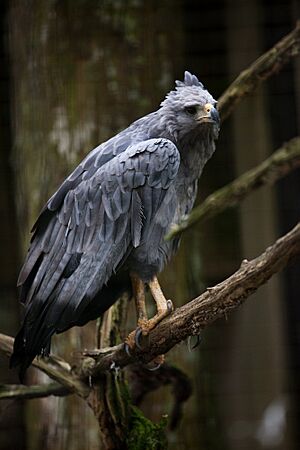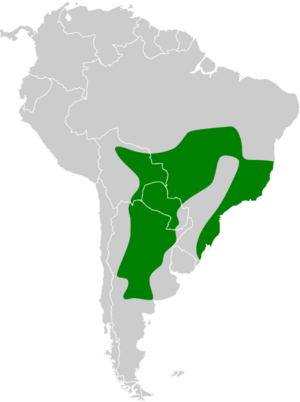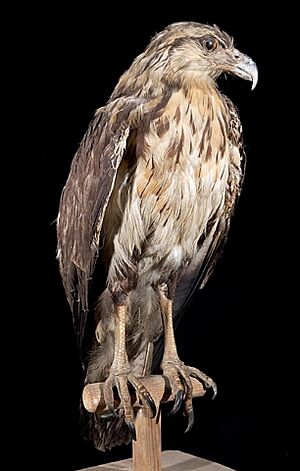Chaco eagle facts for kids
Quick facts for kids Chaco eagle |
|
|---|---|
 |
|
| Conservation status | |
| Scientific classification | |
| Genus: |
Buteogallus
|
| Species: |
coronatus
|
 |
|
| Synonyms | |
|
Harpyhaliaetus coronatus |
|
The Chaco eagle (Buteogallus coronatus), also called the crowned solitary eagle, is a large bird of prey. It lives in eastern and central South America. This amazing bird is endangered, meaning there aren't many left. People often just call it the "crowned eagle." But be careful! There's also an African crowned eagle (Stephanoaetus coronatus). Because the Chaco eagle is so rare, scientists are still learning about its life and how many there are.
Contents
What Does the Chaco Eagle Look Like?
The Chaco eagle is a big raptor. Most of its feathers are a dull, silvery grey. It has a short black tail with a wide white band and a white tip. Its beak area (called a cere) and legs are yellow.
As its name hints, the crowned solitary eagle has a crest of darker grey feathers on its head. Young eagles also have a crest. Their crest is dark brown, but their head and belly are creamy with grey streaks.
This eagle is one of the biggest raptors in the Neotropics. It usually weighs about 2.95 kg (6.5 lb). It can be 73 to 79 cm (29 to 31 in) long. Its wings can spread out to 170 to 183 cm (5 ft 7 in to 6 ft 0 in) wide!
Chaco Eagle Family Tree
The Buteogallus coronatus is a unique species. This means it does not have different types or subspecies. A scientist named Vieillot first described it in 1817. He called it Harpyia coronata.
Later, in 1842, another scientist, Lafresnaye, changed its name. He put it in the Harpyphaliatus group. It was then called Harpyhaliatus coronatus. For a while, the Solitary Eagle (Buteogallus solitarius) was thought to be a type of Chaco eagle.
But new studies looked at their DNA. These studies showed they are actually very close relatives. They are like "sister species." The studies also found that the Great Black Hawk (Buteogallus anthracinus) is also a sister species. Because of this, all three were moved into the Buteogallus group.
Where Chaco Eagles Live
Where They Are Found
This bird is only found in the Americas. It lives in eastern and central South America. You can find it in southern and central Brazil, Bolivia, and Paraguay. Its home also stretches down to Northern Patagonia in Argentina.
It's not clear if the Chaco eagle still lives in Uruguay. It hasn't been seen there in many years. People think it might be gone from that country. The eagle has also disappeared from other parts of its old home. There are very few of them across their range. This makes them one of the rarest and most threatened raptors in the Neotropical area.
Scientists believe there are only about 250 to 999 adult eagles left. The total number of all Chaco eagles is estimated to be between 375 and 1499 birds.
Their Home Environment
Chaco eagles like places that are partly open. This includes open mixed grasslands, bushy areas, savannahs, marshes, and open woodlands. Big trees are very important for the Chaco eagle. They use these tall trees to build their nests.
Dangers They Face
The Chaco eagle is an endangered species. Its numbers are going down. This is mostly because of things people do. Many dangers affect Chaco eagle populations. These include their homes being damaged, hitting human structures, and being hunted by people.
For example, in Argentina, Chaco eagles are still killed. Some people believe they attack farm animals. Between 1999 and 2014, 30 Chaco eagles were taken to a rescue center. They had been shot to protect farm animals. For such a small group of birds, this can really hurt their chances of survival.
This problem has caught the eye of groups that work to protect animals. Argentina has even created a plan to help save the Chaco eagle. It's the only country to do so. Another big problem is eagles getting shocked by power poles. This also greatly affects their numbers. Sadly, this is a common problem for many raptors.
Chaco Eagle Behavior
Chaco eagles are often seen alone or in small groups of two or three. They are calm birds that hunt in the early morning or late evening.
What They Sound Like
You can recognize the Chaco eagle by its loud, sharp whistling call. You can hear it from up to 2 km (1.2 miles) away!
What They Eat
Chaco eagles hunt by sitting quietly on a perch. They wait for their prey. Their diet is mostly small to medium-sized mammals. They mainly hunt armadillos like pichis (Zaedyus pichiy) and nine-banded armadillos (Dasypus novemcinctus). They also eat Andes skunks (Conepatus chinga).
Other mammals they eat include rodents, possums, European hares (lepus europaeus), and lesser grisons (Galictis cuja). Reptiles like snakes, tortoises, and lizards are also a smaller part of their diet. When hunting snakes, eagles often remove the head first. Special scales on the eagle’s legs protect them from snake bites.
Small lizards are caught directly with their claws. But for big lizards like red tegus (Salvator rufescens) and Argentine black and white tegus (Tupinambis merianae), they hunt differently. They approach from the side. They grab the lizard's hip with one foot and its head with the other. This helps them avoid being bitten or hit by the tail. Usually, these raptors hunt and kill their own food. However, some have been seen eating dead deer, sheep, armadillos, and roadkill.
Chaco Eagle Reproduction
Chaco eagles are monogamous. This means they have one partner for life. Between August and October, the female lays a single white egg with grey spots. The nest is like a platform made of sticks and leaves. They build it on the tallest trees in their breeding areas. Nests are usually 10 to 13 meters (33 to 43 ft) above the ground. Some eagles have even nested on human buildings when no trees were available.
The egg hatches about 45 days after it is laid. This usually happens in November or December. The female stays close to her chick from when the egg is laid. She stays until the chick is old enough to be left alone for short times. The male eagle constantly brings food to the nest. The female joins the hunting when the chick hatches and grows a bit bigger. The young eagle will stay in the nest for 65 to 70 days. We don't know much about when they start breeding. But it's thought they don't breed until they are 3 to 5 years old.




